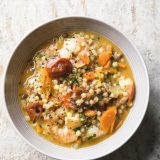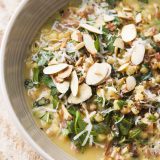Chiesa del Santo Sepolcro is a church divided. Wedged into one of Cagliari’s many steep and sweeping hills that tug the Sardinian capital toward the Tyrrhenian Sea, the weathered stone exterior betrays little of the give-and-take that plays out inside. Only a waft of freshly baked bread, a hint of garlic and fresh herbs, suggest something unusual.
Beyond the entry, two-in-one churches blur and break. To the right, pews and an altar for Roman Catholics, the medieval building’s first inhabitants. Directly ahead, bold and gilded with icons, space for Eastern Orthodox congregants. A divided solution to a shared problem—keeping a church alive in an era of dwindling attendance.
Today, the entire space is given to a parastas, a food-fueled and melodic memorial service for a member of the Romanian immigrant community. For me, it’s an unintended pit stop, a fortuitous escape from a downpour en route to the home of a man who has offered to teach me about fregola, the Italian island’s signature nugget-like pasta.
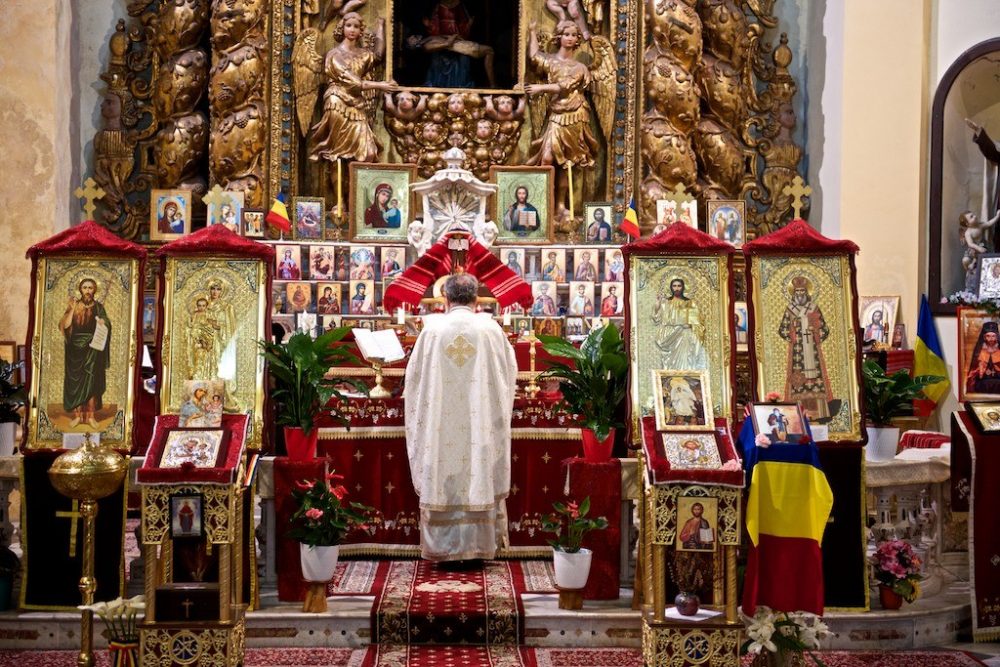
In Sardinia, fregola shows up even at memorial service buffets.
As the priest conducts the Orthodox liturgy for several dozen people, a lone woman at the back fusses over card tables tucked around the pews. A friend died two weeks ago; she has assembled the traditional feast. Rice and beans with mushrooms. Diamond-shaped flaky pastries. Rice pudding adorned with brightly colored gumdrops in the form of a cross. A thick bread braided as a crucifix. Plump stuffed cabbage leaves glistening with oil. Each dish with a thin, lit candle plunged into the center. Bottles of wine and grape and orange Fanta soda to the side.
As the service ends, the priest moves toward the tables. The congregants approach him, each holding a platter of food with extended arms. With incense and bells swinging, he blesses each in turn. The meal begins as the priest recedes to the vestibule, attendees building precarious plates they perch on their laps in the pews.
Invited to join them, I sample everything, but am most taken by the stuffed cabbage. Some are filled with an aromatic mix of rice and herbs. But the ones that most hold my attention contain the very ingredient I’d come to Sardinia for—fregola, a tiny pasta that resembles pearl couscous but cooks up chewy-tender.
"Sardinian cuisine evolved despite rather than because of the sea."
The cabbage with rice is fine, but those with fregola are fantastic. Treated like rice, the fregola produces a cabbage filling at once meaty, light, savory and satisfying. Encouraged, I leave to meet Vincenzo Aresu, a former pharmaceutical executive who has dedicated his retirement to cooking. He has offered to teach me the simple, four-herb fregola he perfected over years of entertaining medical clients.
Aresu’s 17th-century home inspires awe. Rescued from abandon, it boasts vaulted stone ceilings, walls of frescoes, catwalk lofts and an atrium-style kitchen that opens to a church-like dining room domineered by a massive wooden table. He shrugs when asked how he learned to cook. His mother was awful in the kitchen. He watched her, then taught himself.
Sardinian cuisine evolved despite rather than because of the sea, he explains. Buffeting centuries of invaders meant moving inland and avoiding the coast. That shaped Sardinian cooking, historically drawn mostly from vegetables, grains, dairy and lamb. Only in recent decades has the abundance of seafood been tapped.
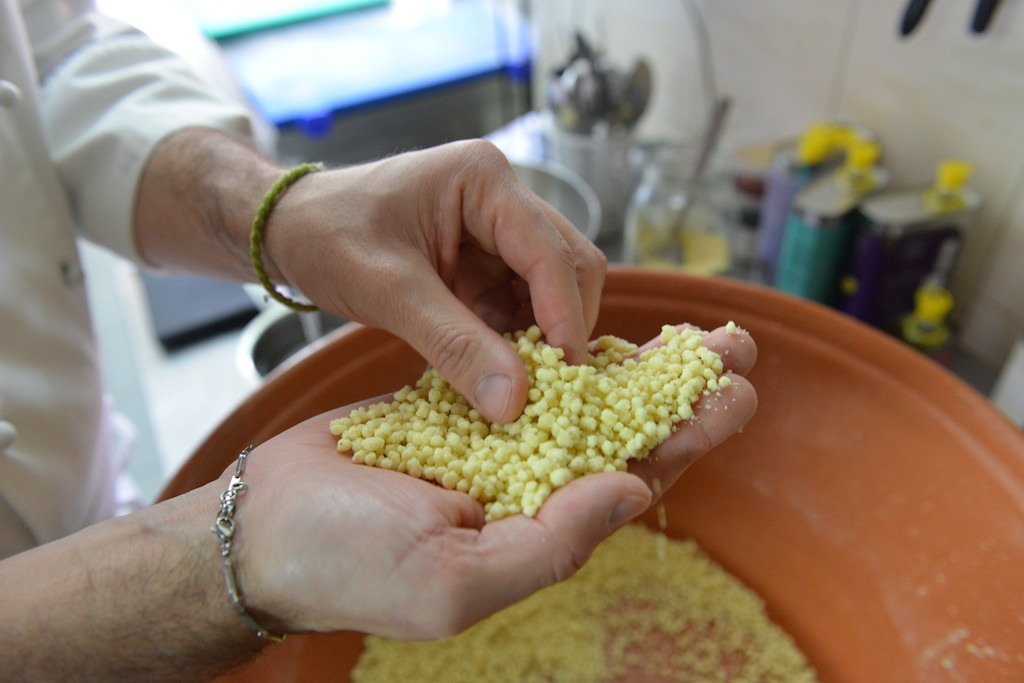
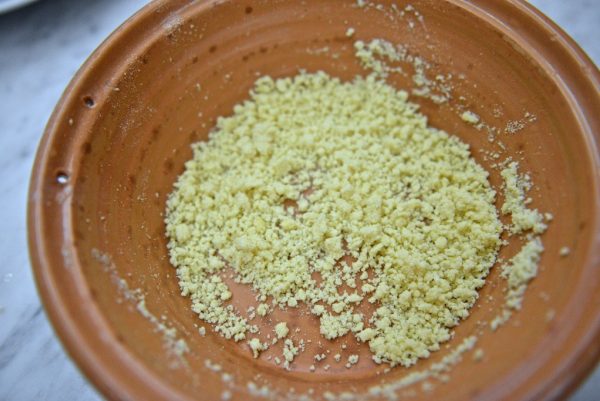
Handmade pasta rarely is part of the Milk Street repertoire. But the simplicity of Sardinia’s tiny, bead-like fregola— no special equipment and no ingredients but semolina flour and water appealed to us. So we asked for a lesson from Trattoria Lillicu chef Francesco Pinna, who prepares it as an aunt taught him when he was a teenager.
He begins by sprinkling a bit of semolina flour and water in a wide, shallow bowl. He then uses his fingertips to stir the mixture until it clumps into small, irregular balls, which he air-dries for 30 minutes before toasting until firm and lightly browned. When cooked like traditional pasta, the fregola has a pleasantly chewy texture.
Fregola, Even Faster
We found we could speed the process—and make more fregola at once—using a food processor. To make, add 1 cup semolina to the processor. While pulsing the processor, drizzle in 6 tablespoons water, pulsing just until the flour begins to clump, about 20 seconds.
Transfer the clumps to a parchment-lined rimmed baking sheet and use your fingers to pinch any large ones into smaller pieces. They need not be uniform, but none should be larger than a pencil eraser. Spread in an even layer, then let air-dry for 30 minutes. Toast in a 350°F oven until lightly browned, about 20 minutes. Stir, then toast for another 5 minutes. Turn off the oven and leave until evenly golden brown, another 15 minutes.
Faux Fregola
Pearl couscous, sometimes called Israeli couscous, makes a good substitute for fregola, but it must be toasted. To toast, put the couscous in a large, dry pot (the same one you’ll later use to cook the dish). Cook over medium, stirring often, until golden brown, about 5 minutes. Even after toasting, the couscous will absorb liquid differently than true fregola, so be sure to adjust the broth as directed in the recipe notes.
Like the pastas of southern Italy, fregola is made from nothing but semolina flour and water. Formed into thick pellets, it is dried, similar to couscous. But then it is toasted until lightly browned. This explains why it retains more chew than couscous after cooking. And like many pastas, it often is best when cooked in the sauce, allowing it to better absorb the flavors of the other ingredients while releasing starch that thickens the dish.
Aresu’s sauce begins with meaty chunks of guanciale crisped in olive oil. The fregola is added, toasting in the savory fat. Meanwhile, handfuls of fresh herbs—basil, parsley, mint and wild fennel—are pureed with a bit of ricotta salata cheese and a mix of pine nuts, walnuts and almonds. The result is pleasantly granular, savory and boldly herbal.
After adding water to plump the fregola, Aresu stirs in the herb puree. He warms it, though not so long as to dull the freshness of the herbs. He then adds a final flourish of olive oil and grated cheese—Parmesan and the local aged pecorino Sardo. The result is richly meaty—though little meat is used in the recipe—and explosively herbal, a vibrant greenness balanced by cheese and starchy, chewy pasta. And it occurs to me: The fregola once again was treated like rice. Deliciously so. The entire process reminded me of the risottos of Milan.
Aresu rounds out the meal with chunks of a friend’s local sausage, another friend’s olive oil-packed marinated artichoke hearts and pickled porcini mushrooms. But I keep going back for the fregola. As I reach for another helping, he tells me that though it’s less traditional, I also must try a seafood fregola. And he knows the perfect place.
For nearly 60 years, Aresu has eaten weekly at Trattoria Lillicu. Sometimes he brings his own homemade wine and olive oil, sharing with diners at nearby tables. “If you eat alone, you are an unhappy person.” We meet there a few hours after our lesson. He is greeted warmly, offered chunks of pecorino as he gives nodding approval to a long table of prepped antipasti.
Longevity here is the norm; the same family has run the restaurant since it opened in the 1930s. Most waiters have worked here for 20 or 30 years. Our chef, Francesco Pinna, has been at the stove for 22 years. His father worked here for 40. The long dining room—pink plaster walls, stone mosaic floors, white marble tables, red granite counters—fills quickly to capacity, some 100 boisterous locals.
Waiters whip in and out with carafes of wine. Our dinner comes in waves. Burrida, a vinegary cold seafood soup. Artichokes awash in olive oil. Tiny fried fish, crisp and lemony, that Aresu eats by the handful. A seafood platter with bright red shrimp, calamari, red snapper. Two giant fish covered in cherry tomatoes, surrounded by hunks of bread fried crisp and soaking up the juices.
My favorite, predictably, is the seafood fregola, a brothy bowl of tiny irregular pasta nuggets bathed in tomato sauce and heaped with mussels, shrimp and calamari. It is rich, but not heavy. Briny, but not fishy. All balanced by the acidity of a brightly flavored sauce spiked with garlic and red pepper flakes. And again, fascinatingly similar to risotto, yet with more robust chew.
The next day, I return so Pinna can teach me first to make fregola from scratch—easily the simplest pasta to make by hand (see sidebar on p. 18)—then to use it in the seafood dish I’d eaten the night before. It begins in the skillet, with olive oil, red pepper flakes, garlic, parsley and cherry tomatoes all simmered until saucy. Then the seafood. Then broth and fregola. In short order, it is done—tender, chewy and brightly flavored.
Back at Milk Street, we followed the leads of Pinna and Aresu—treating the fregola similar to rice. Adapting the recipes was mostly about streamlining and substituting for hard-to-find ingredients. The biggest adaptation was the fregola itself. We loved it, but wanted an option for people who couldn’t find it. The solution was pearl couscous, which essentially is untoasted fregola. Toasting it in a large, dry pot for 5 minutes worked wonderfully. A simple solution for a fantastic pasta, treated like rice whether by land or by sea.
Related Recipes
September-October 2019

Sign up to receive texts
Successfully signed up to receive texts!
We'll only send our very best offers - Like a $15 store credit to start.
By entering your phone number and submitting this form, you consent to receive marketing text messages (such as promotion codes and cart reminders) from Christopher Kimball's Milk Street at the number provided, including messages sent by autodialer. Consent is not a condition of any purchase. Message and data rates may apply. Message frequency varies. You can unsubscribe at any time by replying STOP or clicking the unsubscribe link (where available) in one of our messages. View our Privacy Policy and Terms of Service.
